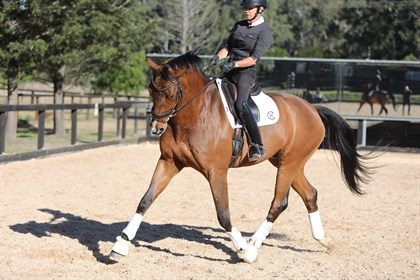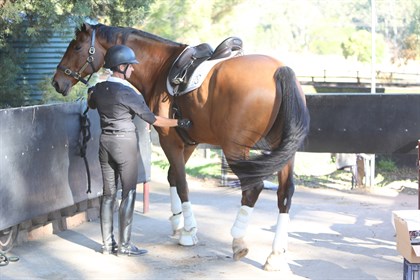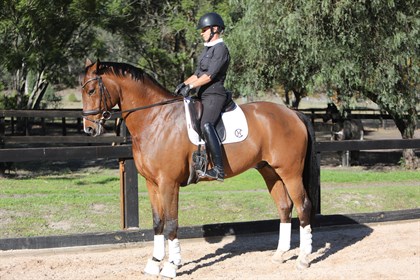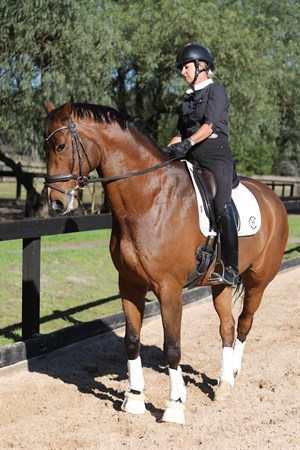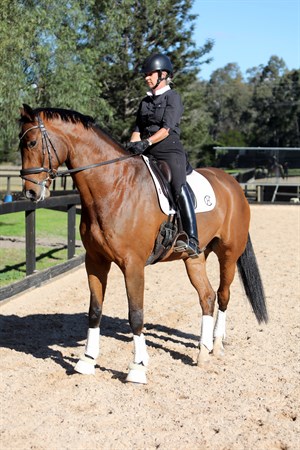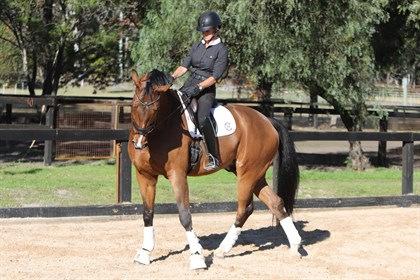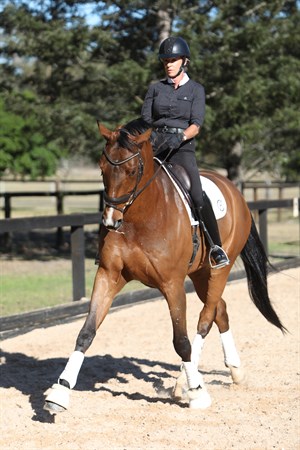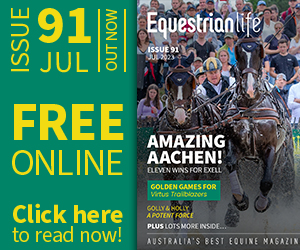
Training at Home with Roger Fitzhardinge: Finding balance on the circle
When we put the call out to our readers to ask our dressage expert, Roger Fitzhardinge, any training questions they might have.
Well, here we have our first question, from David Fry:
“I would love training tips to develop my horse’s balance, my boy continues to fall into circles, and more inside leg doesn't help.”
Here’s what Roger has to say…..
Thanks for the interesting topics that need some simple exercises to help!
The first one we’re covering is ‘Balance’…. especially with a horse that wants to fall in on the circles.
This is probably one of the most common problems in training the young horse and still applies to the Grand Prix ones in a slightly differing way.
Of course it is all to do with being able to ride your horse straight. To be able to ride your horse straight, you must be able to ride him crooked!! Weird but true… So you have to be able to move him off your leg laterally… sideways… and so below are a few steps leading up to riding your horse straight, through crookedness!!!
Steps:
1. Can you move him away from your hand when he is tied up (so he learns to yield to pressure)? You must note the attitude of the neck when you move him over… if he moves away to the right with the hind end, you will note that the neck comes to the left or flexes around you. This attitude and neck and body positioning is going to hold you in good stead for the next exercises. Here, the most basic thing to realise is that when the horse makes the correct move (i.e. moves away from the stimulus that you used to initiate the move) this stops, and a reward in a way that you and your horse know best is affirmative for the correct response. The reward is above all no pressure. Pressure means DO! No pressure is reward.
Yielding to lateral pressure in the wash bay.
Question…
Have you ever tried to lead a foal, horse or cow in a halter when they turn their head and neck away from you? I am sure you have, and the feeling is not good as the next thing they will just nick off and you are out of control. Flexion (in the neck) and bend (in the body) are strategic factors for control, balance straightness and collection. These all lead to better control and a happier, well balanced horse that can perform its ridden activities more easily.
2. Turn on the forehand
Once your horse has realised the moving away from pressure on the ground, it’s time to start from on board. You can read all about it, but basically the horse flexes and bends inwards and moves the hind legs outwards. The front legs stay stationary almost, and the hind legs move around the forehand.
A square halt a metre from the rail is the precursor to the turn on the forehand.
The rider’s inside leg behind the girth pushes the horse laterally (stepping sideways) around the front end. It’s a good idea at the start to have a competent helper on the ground to stand on the inside and use their hand pressure, as your horse was taught on the ground, to move away. What is very important is that the ground person’s prompt comes AFTER the rider’s aid and that they stand quietly at the shoulder and make certain the rider always keeps the horse bending and moving around the handler.
The first step in the turn on the forehand, away from the right leg turning towards the rail.
Further steps, and the horse rotates around the relatively immobile inside foreleg.
3. Leg yielding
This exercise can be done at the walk, trot or canter – but mostly at the trot.
To start, it is a very similar attitude and feeling as in the turn on the forehand. The horse bends and flexes to the inside and the rider’s inside leg asks the horse to move outwards, but now you are travelling more forward. The leg pressure is applied as the horse’s inside hind leg leaves the ground, and in rising trot as the rider rises and moves forwards and across the body and opposite hind leg.
Make a 12ish metre circle in the middle of the school, around X so you are equidistant from the walls. If in trot do not increase the flexion, but get the horse to jump away from the rider’s inside leg so you are effectively enlarging the size of the circle from 12 to 13 to 14 metres etc. You do this like leading the foal, or moving the horse over from the ground. Once the body moves away, then the neck will be soft and easy to move inwards. It’s of the utmost importance that the horse moves away from the rider’s direct leg aid and doesn’t think that inside bend from the rein means move over, as later you will need travers and half pass where the horse bends toward the sideways and the flexion, which is the opposite to the direction of leg yield. It’s just easier to bend left and move right as all these exercises thus far encourage.
The small circle, moving away from the flexion from the inside leg.
Next exercise is to go from the wall onto a 15 metre circler and then leg yield out to a 20 metre circle and to make sure you do this equally on both reins; you will soon find out which is the stiff side (hard to bend and flex) and which is the hollow (easy to bend and flex). Remember always LEG before the hand. On the stiff side, once you initiate the movement and the bend starts, then encourage the flexion. On the hollow side don’t allow too much flexion and falling out. I say only bend as much to the supple side as you can to the stiff side, and often the more pliable side is harder to ride honestly straight.
Leg yielding off the circle, away from the bending.
The next exercise will be leg yield out from a straight line.
Ride down the ¼ line, say off the right rein. Right bend and flexion and go to the left, away from the flexion and have the shoulders a little in the lead and if reluctant to begin, you can open the outside rein a little to initiate and if no success then go back and re-explain the leg yield on the half circle to the larger circle, then the half circle to the straight line again towards the wall.
Now you have some great exercises to aid in stopping your horse from falling in on the circles.
The leg yield from the 1/4 line to the long side, to the right. Note the slight flexion away from the sideways movement and the rider’s inside leg slightly behind the girth asking the horse to move over as it leaves the ground.
I hope this has been helpful and if at any stage you run in to trouble don’t hesitate to get back to Equestrian Life and ask for more help. The next exercise you need to read about once you have mastered the leg yield is shoulder-in and more on that at another meeting.
Enjoy your training and remember clear, well understood aids repeated the same EVERY time. Take time, explain carefully and above all be patient and make sure you reward often for any thoughts along the right way. Your horse will learn quickly and enjoy the experience!
Images © Roger Fitzhardinge
READ THE LATEST NEWS ARTICLES HERE
https://www.equestrianlife.com.au/articles/Training-at-Home-with-Roger-Fitzhardinge-Finding-balance-in-the-circle
